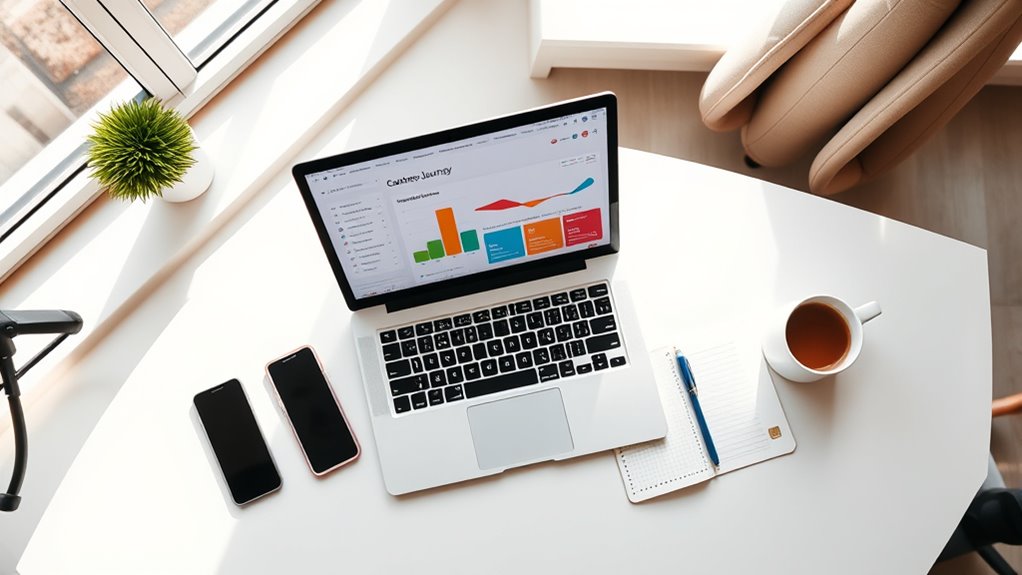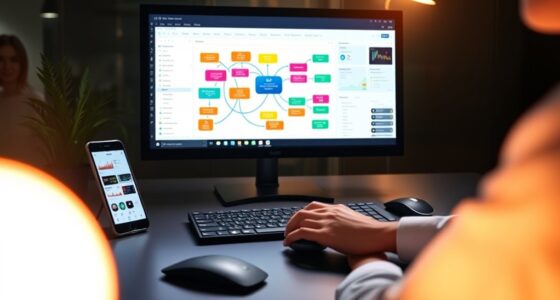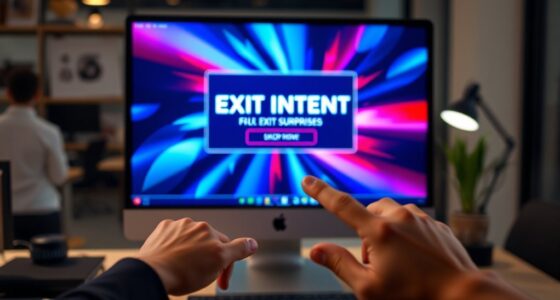To align your inbound email strategy with customer journey stages, focus on personalized, targeted messaging at each phase. In the awareness stage, capture attention with relevance based on actions like site visits or content downloads. During consideration, nurture relationships with segmented, tailored content. In the decision phase, send personalized offers or demos to motivate actions. Post-purchase, reinforce loyalty with exclusive perks. By integrating these tactics, your strategy becomes more effective—continue exploring to discover how to optimize each step.
Key Takeaways
- Use personalized subject lines and content tailored to each customer journey stage to increase relevance.
- Segment your audience based on behavior, demographics, and engagement to deliver targeted messages.
- Align email calls-to-action with the specific goals of each stage, such as awareness, consideration, or purchase.
- Incorporate nurturing tactics in the consideration phase to build relationships and guide prospects toward decision-making.
- Provide ongoing value and loyalty incentives post-purchase to foster retention and deepen customer relationships.

An effective inbound email strategy is essential for building strong relationships with your audience and driving engagement. To do this successfully, you need to align your emails with each stage of the customer journey. When prospects first discover your brand, your goal is to grab their attention and spark interest. During this awareness stage, personalization tactics become indispensable. By tailoring your subject lines and content to match their initial interests or behaviors, you show that you understand their needs. For example, if someone downloaded a specific ebook or visited a particular product page, referencing that in your email makes your message more relevant and enticing.
Personalize your emails during the awareness stage by referencing initial interests and behaviors to increase relevance and engagement.
As your contacts move into the consideration phase, your focus shifts to nurturing those relationships. Here, list segmentation plays a key role. Segmentation allows you to divide your audience into smaller groups based on demographics, behaviors, or engagement levels. When you send targeted emails to these segments, your messaging becomes more precise and valuable. For instance, you can send different content to first-time visitors versus repeat customers, addressing their unique concerns. This tailored approach increases the likelihood of converting interest into a purchase or deeper engagement.
When prospects reach the decision stage, your emails should aim to motivate action. Offers, demos, or free trials become more effective when they’re customized to the recipient’s previous interactions. Personalization tactics help you craft compelling calls to action that resonate with each individual. For example, referencing their browsing history or past inquiries shows you’re paying attention, making it easier to persuade them to take the next step. List segmentation again proves useful here, as it enables you to deliver the most relevant offers and messages, avoiding unnecessary or irrelevant emails that could cause disengagement.
Post-purchase, your focus shifts to retention and loyalty. Your emails should acknowledge their commitment and provide ongoing value, such as exclusive content or loyalty rewards. Personalization continues to be indispensable—using the customer’s name, purchase history, or preferences makes your communication feel genuine and appreciated. Segmentation helps you identify and target different customer groups with tailored messages, ensuring that your retention strategies are as effective as your acquisition efforts. Additionally, understanding divorce statistics can inform how you craft empathetic and relevant content for your audience, especially if your brand addresses life transitions or legal support.
Frequently Asked Questions
How Can I Personalize Emails for Different Customer Segments?
You can personalize emails for different customer segments by leveraging segmentation strategies to group your audience based on demographics, behaviors, or preferences. Use personalization techniques like customized subject lines, dynamic content, and tailored messaging that resonate with each segment’s needs. Continuously analyze engagement data to refine your approach, ensuring your emails feel relevant and valuable, which boosts open rates, clicks, and overall customer satisfaction.
What Metrics Best Measure Email Strategy Success?
Imagine you send targeted emails, and you want to see if they’re effective. You should track email open rates to gauge initial engagement and click-through metrics to measure deeper interest. For example, if open rates are high but click-throughs are low, you know your content needs improvement. These metrics give you clear insights into your email strategy’s success and help you optimize future campaigns effectively.
How Do I Integrate Email With Other Marketing Channels?
You should integrate email with other marketing channels by using segmentation strategies to target your audience effectively across platforms. Combine email automation with social media, content marketing, and paid ads to create a seamless customer experience. Use automation to personalize messages based on behaviors, ensuring your messaging remains consistent. This approach boosts engagement and helps guide your audience through their journey, making your overall marketing efforts more cohesive and effective.
What Are Common Pitfalls in Aligning Email With Customer Stages?
You may stumble into common pitfalls like neglecting lead nurturing or failing to use email automation effectively. If you don’t segment your audience properly, your emails won’t match customer stages, leading to disengagement. Overloading prospects with irrelevant messages can also hurt your strategy. To avoid this, focus on personalized, automated campaigns that guide leads smoothly through their journey, ensuring your email efforts support and enhance their experience at every stage.
How Often Should I Update My Email Content Based on Customer Feedback?
You should update your email content regularly, ideally every few months, to keep it fresh and relevant. Incorporate customer feedback promptly—whenever you notice patterns or new suggestions—to improve engagement. The email update frequency depends on how quickly your customers’ needs evolve, but staying responsive guarantees your messaging remains aligned with their expectations. Consistently incorporating customer feedback helps build trust and enhances the overall effectiveness of your email strategy.
Conclusion
Think of your inbound email strategy as a well-tuned orchestra, each message playing in harmony with your customer’s journey. When you align your emails with their needs at every stage, you create a seamless symphony that guides them effortlessly toward conversion. Keep tuning your approach, listen to their signals, and let your emails resonate at just the right moments. Together, you’ll craft an experience that not only engages but also builds lasting relationships.








